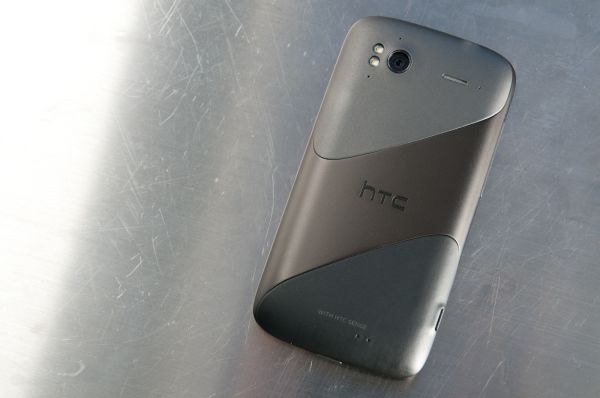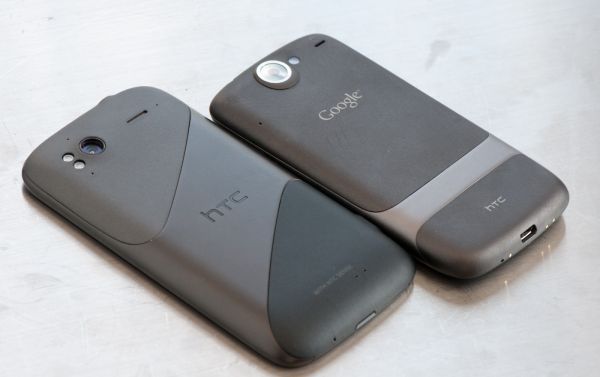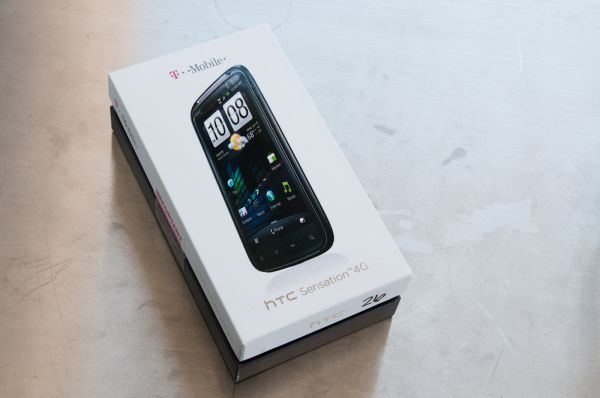HTC Sensation 4G Review - A Sensational Smartphone
by Brian Klug on July 1, 2011 12:38 AM EST- Posted in
- Smartphones
- HTC
- Android
- Mobile
- HTC Sensation
- MSM8260
I like what HTC has been up to lately. Rather than fighting a race to the bottom with endless soulless variants of the same piece of hardware in a crowded (and fiercely competitive) Android handset market, it’s trying to grow beyond just being a handset manufacturer.
I hate starting reviews with history lessons, but in this case we really do need to step back to see where HTC is coming from. In the beginning, HTC was a nameless OEM for other more famous brands. Its clients were smartphone and Pocket PC names like Palm with its Treo, Compaq with its iPaq, Dell with a number of the Axim PDAs, and UTStarcomm. As Windows Mobile aged and showed little signs of improving, HTC took its first step outside the bounds of being just a hardware assembler by taking on an ambitious project to revitalize Windows Mobile with a software skin. The fruits of this effort were TouchFlo, and later TouchFlo 3D UIs - which eventually would become HTC Sense. Somewhere between the release of the HTC Mogul and HTC Touch Pro, HTC realized that its future wasn’t purely in manufacturing devices for other handset vendors, but in leveraging its own brand. The combination of continually improving industrial design, software, and its own direction have turned HTC into the device manufacturer it is today.
Things have come a long, long way since the HTC Dream, and today we’re looking at HTC’s latest and greatest with the HTC Sensation.
I get a bit excited every time I look at the HTC Sensation. It’s a device with perhaps the strongest and most bold design language of any HTC phone to date. You can pretty much chart HTC’s design language by looking at each generation of its international handsets.
The HTC Desire was essentially an international version of the Nexus One, with hardware buttons but the same 65nm single core Snapdragon QSD8250 SoC. The second generation was the HTC Desire HD, which brought a larger 4.3” screen and 45nm Snapdragon MSM8255 SoC. The third step is the HTC Sensation, which ups resolution from WVGA 800x480 to qHD 960x540 and brings a 45nm dual core Snapdragon MSM8260 SoC.
| Physical Comparison | ||||||
| Apple iPhone 4 | HTC Thunderbolt | LG Optimus 2X/G2x | HTC Sensation | |||
| Height | 115.2 mm (4.5") | 122 mm (4.8") | 123.9 mm (4.87") | 126.3 mm (4.97") | ||
| Width | 58.6 mm (2.31") | 67 mm (2.63") | 63.2 mm (2.48") | 65.5 mm (2.58") | ||
| Depth | 9.3 mm ( 0.37") | 13.2 mm (0.52") | 10.9 mm (0.43") | 11.6 mm (0.46") | ||
| Weight | 137 g (4.8 oz) | 183.3 g (6.46 oz) | 139.0 g (4.90 oz) | 148 g (5.22 oz) | ||
| CPU | Apple A4 @ ~800MHz | 1 GHz MSM8655 45nm Snapdragon | 1 GHz Dual Core Cortex-A9 Tegra 2 AP20H | 1.2 GHz Dual Core Snapdragon MSM8260 | ||
| GPU | PowerVR SGX 535 | Adreno 205 | ULP GeForce | Adreno 220 | ||
| RAM | 512MB LPDDR1 (?) | 768 MB LPDDR2 | 512 MB LPDDR2 | 768 MB LPDDR2 | ||
| NAND | 16GB or 32GB integrated | 4 GB NAND with 32 GB microSD Class 4 preinstalled | 8 GB NAND with up to 32 GB microSD | 4 GB NAND with 8 GB microSD Class 4 preinstalled | ||
| Camera | 5MP with LED Flash + Front Facing Camera | 8 MP with autofocus and dual LED flash, 720p30 video recording, 1.3 MP front facing | 8 MP with AF/LED Flash, 1080p24 video recording, 1.3 MP front facing | 8 MP AF/Dual LED flash, VGA front facing | ||
| Screen | 3.5" 640 x 960 LED backlit LCD | 4.3” 800 x 480 LCD-TFT | 4.3" 800 x 480 LCD-TFT | 4.3" 960 x 540 S-LCD | ||
| Battery | Integrated 5.254Whr | Removable 5.18 Whr | Removable 5.6 Whr | Removable 5.62 Whr | ||
Physically it’s obvious that each successive device builds on the former. They’re all backed with HTC’s trademark purple-grey metal and have similar in-hand feel as a result. When I look at the Sensation, I see the Desire crossed with the Desire HD. When I actually hold the Sensation, I feel like I’m holding a grown-up Nexus One.
The two share that trademark combination of slightly rubbery plastic and metal, and as a result the device feels grippy, solid, and confident. What the Sensation also really continues from the other devices is the lack of a hard lip of any kind at the edge, instead every corner rolls off giving the phone a smooth feeling. The sensation of holding something rigid and expensive is communicated by that combination of materials, rather than the cheap plasticky feel conveyed by a number of other handsets.
The Sensation comes in the same style of packaging that we've seen other T-Mobile phones arrive in. It's a two-part box with a thin middle strip. The top lifts off revealing the phone, and underneath that is the usual paperwork, HTC AC adapter and microUSB cable, and earbuds.
I started off making one monolithic video for the Sensation, but that ended up being unwieldy, so I split it into multiple parts. The first one is simply a look at the hardware from all angles, torn down, and how it compares to both HTC's legacy devices and some of its modern contenders.



















107 Comments
View All Comments
StormyParis - Friday, July 1, 2011 - link
and I was looking forward to getting the Sensation, especially for its big, high-rez screen.I'm thinking of going the Galaxy S 2 route instead:
- GS2 is much lighter (115 vs 150 grams). Less sagging pants and shirt pockets sound really nice (I currently have a 155g HD2)
- screen seems better: fewer pixels, but much better contrast and angles
- Samsung actively supports CM7, I'm not even sure if the Sensation is unlocked (HTC says they're no longer locking, I don't know if originally locked devices get an unlock)
- everything else seems broadly the same. camera maybe a bit better on the GS2
piroroadkill - Friday, July 1, 2011 - link
I personally think the HTC Sensation looks much nicer than the Galaxy S II, and it also provides all 4 Android buttons, which is more useful.Also, Sense 3 is a genuinely nice addition, so I REALLY don't understand the lust for AOSP based ROMs.
I know which phone I'll be recommending if people ask me...
kaworu1986 - Friday, July 1, 2011 - link
I actually registered just to post this, and here it goes:Sense (and the other skins) just need to DIE: they're bloated, ugly and inefficient (not to mention introduce bugs that stock Android does not have); worse than that, they are way of creating vendor lock-in and force users to upgrade hardware by withholding Android updates (a very clever trick to neuter one of the greatest advantages of Android, its open source nature).
Why can't OEMs just stick to do their job? People complain about the crapware OEMs install on PCs (which at least you can uninstall or just format) and somehow this is OK? Also, commodization is exactly what makes the PC ecosystem great: customers can shop around for the best price for their performance needs without having to worry about their devices being left without a software upgrade path or features unavailable. And with phone makers locking their bootloaders the last way of getting out of their death grip, custom ROMs, are being taken away from us.
Finally, I'd much rather rely on software written by a good software company (Apple, MS, Google) with 100s of engineers dedicated to the project than the much smaller team an OEM can afford to put on the job.
piroroadkill - Friday, July 1, 2011 - link
Well, I have a Desire HD, rooted, s-off, I can put whatever the hell I want on it...Oh, and I choose to use a sense based ROM with Sense 3. I've had a phone with pure CyanogenMod, it's all well and good, the point is, as long as the phone isn't horribly locked, and xda-dev get their dirty mitts on it, you can have whatever yo uwant!
piroroadkill - Friday, July 1, 2011 - link
Oh, that said, I don't use the launcher. I use Launcher Pro.Chloiber - Friday, July 1, 2011 - link
Exactly the same here, except I'm using a Desire (non-HD). I really like Sense. I rooted the phone about one year ago and was using Stock Android ROMs a lot. I really liked it. Now I returned to a Sense 2.1-3.0 mix and I like it even more. Some things are simply better with Sense. I also replaced the launcher with LauncherPro (also on Stock Android) because it gives you a really nice, smooth experience. In this regard, pretty much every stock browser, be it Sense or stock Android have failed thus far.@Brian
Strange that Brightness, Airplane Mode and Screen Rotation is missing, as it is included in Sense 2.1 (for example Desire S). But you probably already knew that, as you listed exactly the 3 things that are included there... :-)
shabby - Sunday, July 3, 2011 - link
Aosp ui is pretty archaic compared to touchwiz/sense, it lacks a lot of features that makes the phone more user friendly to the average person.Compare the aosp lockscreen to the sense3 lockscreen, which do you think the average person would want? Compare the widgets from touchwiz4 to the widgets of aosp... oh wait there aren't any in aosp. Catch my drift? Majority of users aren't like you and me that want a plain aosp/cm7 phone, so sense/touchwiz will never die, top selling phones will never be plain google aosp phones because that's not what majority of the public wants.
JasonInofuentes - Monday, July 4, 2011 - link
I think it's important to keep in mind that AOSP was designed with UI modifications in mind. It's not like HTC/Moto/Sammy/LG/Lenovo/Sony got their hands on source and went to work altering it against Goog's wishes. They wanted to be supportive of modifications to the OS from corporations and amateurs alike.Yes, the course was lost as manufacturers delayed updates in order to implement their UI, and some of the UIs were buggy, but then again lots of popular custom ROMS are buggy and users still love them. The point is, if there's value added, which in the case of Sense 3.0 and, by reports, the new Blur then it might be worth the cost to many. But devs should work with Google to make sure that their skins add without being too deleterious. Where I think all OEM devs should back off is in integrating social media streams; unless your implementation is decidedly better than the best social media apps then it's likely going to be a redundant, unwelcome presence.
mikehunt80 - Friday, July 1, 2011 - link
I don't think I've ever used the search button in previous devices, but I guess that's personal preference.I tried out the Sensation before buying the Galaxy S2. There was absolutely no contest. The S2 felt snappier browsing the web (A9 is 25% quicker clock for clock vs. A8/snapdragon), much lighter and nicer to hold without feeling cheap or creaking and I thought the screen on the Sensation was fairly poor in comparison. On top of that the S2 will play absolutely any video you throw at it, I'm told it'll even play 1080p mkvs and my 720p mkv Avatar makes people's jaws drop on the S-Amoled+ screen.
The Sense launcher is nice, but I use Go Launcher EX, which has most of the features of the Sense and is almost infinitely customizable. The Sense lock widgets screen looks nice, but is useless is you use pattern or pin lock.
Both great phones, but the S2 to the more rounded device for me.
piroroadkill - Friday, July 1, 2011 - link
Good point on the video compatibility.It best bloody play 1080p mkv though, since my dirt cheap chinese tablet (<$200) can play 1080p mkv without any pauses.
That's one thing a lot of the top tier devices miss, and I agree that that actually swings things in favour of the Galaxy S II..